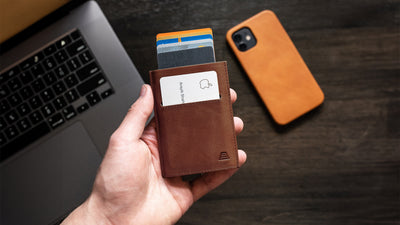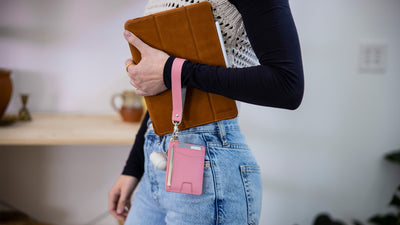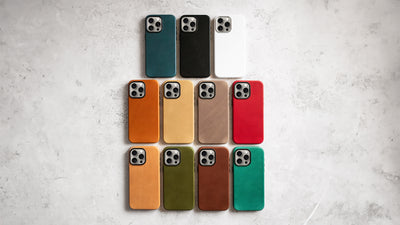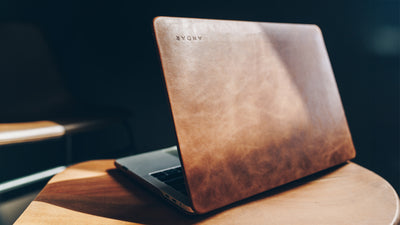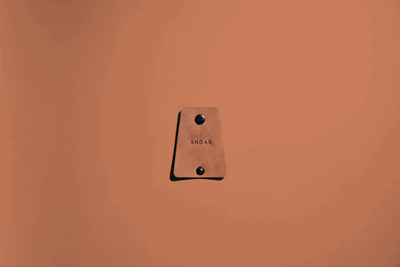The Blog
What Is Patent Leather vs Leather?

At Andar, we often get asked, "What is patent leather vs leather?"
Patent leather is real leather with a high-gloss finish and synthetic coating, making it sleek and shiny. In contrast, genuine, uncoated leather, like our full-grain leather products, offers a natural texture, breathability, and superior quality.
As experts in handcrafted leather goods, we believe genuine leather surpasses patent leather due to its resilience and ability to develop a rich patina over time.
In this article, we'll explore the differences between patent leather and genuine leather, discuss their unique characteristics, and explain why genuine leather is the better choice overall.
Join us as we delve into the fascinating world of leather craftsmanship!
What this article covers:- What Are the Differences Between Patent Leather and Genuine Leather?
- What Is Patent Leather vs. Leather FAQs
What Are the Differences Between Patent Leather and Genuine Leather?
Patent leather and genuine leather are popular materials with distinct characteristics and applications.
Let's dive into their key distinctions.
Table: Differences Between Patent Leather And Genuine Leather
|
Feature |
Patent Leather |
Genuine Leather |
|
How It's Made |
|
|
|
Durability |
|
|
|
Breathability |
|
|
|
Flexibility |
|
|
|
Water Resistance |
|
|
|
Scratch Resistance |
|
|
|
Care |
|
|
|
Cost |
|
|
How It's Made
Patent leather is crafted using two conventional treatment methods:
- Coating Method: This is achieved by applying a high-gloss coating to a leather or synthetic base to the patent leather. This process utilizes multiple layers of lacquer or plastic, which creates its signature shiny surface.
- Composite Method: The composite method involves applying a polyurethane and acrylic solution to the leather surface, creating a smooth, glossy, and reflective finish.
Based on our observations at Andar, patent leather is treated to be visually appealing but sacrifices some of the natural qualities of genuine leather.
If you're wondering, ‘What is the most durable leather?' Genuine leather, particularly oil-waxed, full-grain leather, undergoes an extensive process in contrast to make it exceptionally resilient.
It starts with tanning the raw hides to prevent decomposition, followed by:
- pre-processing
- softening
- dyeing
- finishing
These steps ensure that genuine leather maintains its natural texture and longevity ahead of patent leather.
Durability
Our investigation demonstrated that genuine leather is more durable than patent leather.
Genuine leather develops a patina over time, which adds to its character and resilience. This can be seen in leather wallets like The Scout.
In contrast, patent leather is prone to cracking and yellowing, especially with frequent and improper use.
Breathability
If you're wondering, ‘What is breathable leather?' Our research indicates that the natural fibers in genuine leather allow air to circulate, making it more comfortable for prolonged use ahead of patent leather.
On the other hand, patent leather's synthetic coating limits breathability and can potentially lead to damage and warping quicker than genuine leather.
Flexibility
Genuine leather is more flexible and conforms better to the shape of the user over time.
This is especially true of our Andar watch bands for Apple watch like The Watch Band. After trying out this product, we discovered that it's both Apple Watch-compatible and fits most wrists between 160mm-210mm.
Conversely, patent leather is generally stiffer, which can be limiting in terms of comfort and adaptability.
Water Resistance
Patent leather exhibits high water resistance due to its treatment, making it suitable for environments where exposure to moisture is a concern. While not entirely waterproof, genuine leather can handle moisture better if properly treated and conditioned.
Scratch Resistance
Patent leather offers moderate to high scratch resistance due to its coated surface. Conversely, genuine leather's scratch resistance can vary, and while it might show marks, these often positively enhance its unique appearance.
Care
Both patent and genuine leather require similar steps for cleaning and maintenance:
- Dust And Wipe Down The Surface: Regular dusting and wiping are essential. Use a soft cloth made of microfibers to maintain the surface's appearance.
- Use A Damp Cloth For Stains: For minor stains, a damp, microfiber cloth and our Andar leather leather cleaner (found in The Leather Care Kit) are effective. Our analysis of these products revealed that they work well for both patent and genuine leather. However, avoid soaking the leather, as this can cause warping, shrinkage or creases.
- Apply A Leather Cleaner: Applying our dedicated leather conditioner is crucial to maintain the shine and longevity of both genuine and patent leather.
- Dry The Surface: Always ensure that both the genuine and patent leather are thoroughly dried after cleaning and conditioning to prevent water damage.
Cost
Through our practical knowledge, we discovered that genuine leather typically costs as much as $1000 due to its quality and durability. Patent leather is generally more affordable and costs as little as $25, but doesn't last as long as real leather.
While both patent leather and genuine leather have unique attributes and specific applications, we at Andar believe genuine leather stands out due to its natural beauty, resilience, and timeless appeal.

What Is Patent Leather vs. Leather FAQs
Does Patent Leather Crack?
Patent leather can crack, especially if it isn't properly cared for. The glossy finish, while attractive, can become brittle over time if exposed to extreme temperatures or if it dries out.
Our research indicates that regular conditioning with products designed for patent leather can help maintain its flexibility and prevent cracking.
We recommend storing patent leather items in a cool, dry place away from direct sunlight to preserve their appearance and durability.
Does Patent Leather Stretch With Wear?
Patent leather doesn't stretch as much as genuine leather due to the coating that gives it its shiny finish. While patent leather might mold slightly to the shape of the wearer's feet or hands, it won't stretch significantly.
For items that require a lot of flexibility, such as gloves or shoes, genuine leather is a better option in this context.
Why Is Patent Leather Yellow?
Patent leather can turn yellow over time due to exposure to sunlight and air. This discoloration is a natural process that occurs as the materials used in the patent finish degrade.
Our findings show that storing patent leather items in a dark, cool place and keeping them covered can help slow down this yellowing process. Regular cleaning and conditioning with The Leather Care Kit can also help maintain their original color longer.
Is Patent Leather Vegan?
Patent leather is typically made from real leather that's coated with a glossy finish, so it's not vegan. However, there are synthetic versions of patent leather available that don't use any animal products.
Based on our first-hand experience, these synthetic options can offer a similar look and feel to traditional patent leather, making them a good choice for those seeking vegan alternatives.

Conclusion
In our discussion of ‘What is patent leather vs leather?' We explored the unique benefits of both materials. Patent leather stands out with its glossy finish, while genuine leather excels in robustness, premium materials, and a beautiful aging effect.
We believe in providing premium leather products that help you ‘carry what matters' in style. That's why we encourage you to explore our handcrafted full-grain leather collection now at Andar and find the perfect piece to elevate your everyday essentials.
If you want to learn more, why not check out these articles below:
- How to Make Cactus Leather
- What Is Retro Leather
- What Is Natural Leather
- How Is Cork Leather Made
- What Is Responsible Leather
- Best Leather Backpack Purse
- Best Men's Leather Work Bag
- Best Mens Leather Weekend Bag
- Best Leather Fanny Pack
- Best Leather Shoulder Bags
- Best Black Leather Bags
- Best Leather Backpack
- Best Leather Backpacks for Women
- Best Mens Leather Backpacks
- Best Leather iPhone Case
